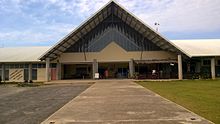Santo-Pekoa International Airport
| Santo-Pekoa International Airport | |||||||||||
|---|---|---|---|---|---|---|---|---|---|---|---|
 |
|||||||||||
| Summary | |||||||||||
| Operator | Airports Vanuatu Limited | ||||||||||
| Location | Luganville, Vanuatu | ||||||||||
| Elevation AMSL | 184 ft / 56 m | ||||||||||
| Coordinates | 15°30′21″S 167°13′17″E / 15.50583°S 167.22139°ECoordinates: 15°30′21″S 167°13′17″E / 15.50583°S 167.22139°E | ||||||||||
| Map | |||||||||||
| Location of airport in Vanuatu | |||||||||||
| Runways | |||||||||||
|
|||||||||||
|
Sources: World Aero Data, Great Circle Mapper
|
|||||||||||
| Pekoa Airfield | |
|---|---|
| Espiritu Santo, New Hebrides Islands | |
| Coordinates | 15°30′18.12″S 167°13′11.07″E / 15.5050333°S 167.2197417°E |
| Type | Military Airfield |
| Site information | |
| Controlled by |
United States Army Air Forces United States Navy |
| Condition | abandoned |
| Site history | |
| Built | 1942 |
| Built by | Seebees |
| In use | 1942-5 |
| Materials | Coral |
Santo-Pekoa International Airport is an airport in Luganville on Espiritu Santo in Vanuatu (IATA: SON, ICAO: NVSS). Airports Vanuatu Limited provides aviation services for the airport.
The 7th Naval Construction Battalion arrived on Santo on 11 August 1942 and began construction of more extensive air facilities to support the Guadalcanal Campaign. After completing a second fighter airfield at Turtle Bay they began constructing two bomber fields, one at Palikulo Bay known as Bomber Field No. 1 and the other at Pekoa, known as Bomber Field No. 2. Working in cooperation with a company of the US Army 810th Engineer Aviation Battalion, the 7th Battalion cleared, graded, and surfaced a 5,000 feet (1,500 m) by 150 feet (46 m) coral runway on the site of a prewar plantation. The 15th Naval Construction Battalion arrived on Santo on 13 October 1942 and extended the runway to 7,000 feet (2,100 m) with pierced steel planking over a coral base, and built taxiways, revetments, and miscellaneous structures. The completed airfield was operational in December 1942 and was known as "Bomber Field No. 2" or "Pekoa Field".
The Thirteenth Air Force was based at Pekoa from 13 January 1943 until 20 January 1944 when it moved to Carney Airfield on Guadalcanal. Units assigned were:
As the war moved further north, Pekoa Airfield was closed on 8 February 1945 and all traffic routed to Palikulo Bay Airfield.
Luganville Airfield was used as a civilian airstrip until the early 1970s, however as it was on higher ground it was often clouded in and so it was decided to move all operations to the former Pekoa Airfield/Bomber Field No.2 which became Santo-Pekoa International Airport.
...
Wikipedia

